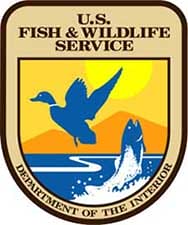

USA-(Ammoland.com)-Few birds match America’s majestic bald eagle for inspiring awe.
Winter is prime viewing season for these incredible raptors, which often are more visible against the backdrop of the season’s sparse landscape. Head to a national wildlife refuge to try to spot an eagle on your own or, better still, head to one of these refuges for an organized tour:
ILLINOIS
Crab Orchard National Wildlife Refuge, in the greater Marion area
Bald Eagle Tours
January 24 and 31, 8 a.m., 11 a.m. and 2 p.m.
January 25 and February 1, 11 a.m. and 2 p.m.
Take a guided van tour to see an active bald eagle nest and other
eagle hangouts. Seating is limited. $5 for adults, $2.50 for youth
under 12. Scout groups can take part in 8:30 a.m. tours on January 25
and February 1. Reservations are required. Call 618-997-3344 ext. 1.
IOWA
Upper Mississippi River National Wildlife and Fish Refuge, near Clinton
Clinton Bald Eagle Watch
January 10, 8:30 a.m. to 2:30 p.m.
In winter, bald eagles – sometimes numbering in the hundreds – hunt
the open water below the river’s locks and dams, swooping down to
catch fish. Take a free shuttle bus from Clinton Community College to
Lock and Dam 13 for the January 10 event, co-sponsored by the refuge.
The refuge surrounds the lock and provides excellent viewing
opportunities. Aerial displays are at their peak from January through
March. Call 815-273-2732 for more information.
MARYLAND
Blackwater National Wildlife Refuge, on the Eastern Shore of the Chesapeake Bay
Eagle Festival
March 14, 2015
More than 200 bald eagles winter on the refuge, which supports one of
the highest concentrations of eagles on the East Coast. The free
festival includes kids’ activities, guest speakers and exhibits, as
well as several “eagle prowls” – short bus tours to see active eagle
nests. Pre-registration is not required. Call 410-228-2677.
MISSOURI
Squaw Creek National Wildlife Refuge, about 100 miles north of Kansas City
Bald eagles generally hang out here all winter unless there’s a deep
freeze. Spring migration brings in newcomers from February to April. A
1.5-mile hiking trail called Eagle Overlook offers eagle viewing from
the wetlands.
OKLAHOMA
Sequoyah National Wildlife Refuge, in the eastern part of the state
Eagle Tours
January 24, 9 a.m. to noon
January 31, 9 a.m. to noon
February 7, 9 a.m. to noon
February 14, 9 a.m. to noon
February 21, 9 a.m. to noon
February 28, 9 a.m. to noon
March 7, 9 a.m. to noon
Take a free guided bus tour to see nesting bald eagles. Use spotting
scopes to get an up-close view of the eagles from the warmth of the
bus. Reservations are not required.
Wichita Mountains Wildlife Refuge, in the southwestern quadrant
“In Search of Eagles” Tour
January 10, 11, 17, 18, 24, 25, 31
February 1, 7, 8, 14,
Take a bus tour to search for bald and golden eagles. Children must be
8 or older. $5 per person. Saturday and Sunday tours depart from the
visitor center at 1:30 p.m. The three-hour tour includes a bus ride
and a short walk. Reserve a space for a tour. Call 580-429-2197.
OREGON/CALIFORNIA
Klamath Basin Refuges
Winter Wings Festival
February 12-15
Even if you miss the Winter Wings Festival, held each year on
Presidents’ Day Weekend, you have a good chance of seeing large
numbers of bald eagles around Lower Klamath and Tule Lake refuges in
winter. Eagles feed on the abundant waterfowl that live in
surrounding fields. Stop at the Tule Lake Visitor Center, 4009 Hill
Road, Tulelake, Calif., to learn where the highest concentrations of
bald eagles are.
TENNESSEE
Reelfoot National Wildlife Refuge, Union City
Free Eagle Tours
Every weekday in February, 8 a.m. and noon
Take a six-person bus tour along Grassy Island Wildlife Drive to the
viewing tower over Reelfoot Lake, where the abundant ducks and geese
draw eagles. Get a close-up look at two active bald eagle nesting
sites. Bald eagle numbers peak in February, with more than 200
wintering eagles around Reelfoot Lake. Resident eagles account for
around 32 nests. Some parts of the refuge close in the winter as
waterfowl sanctuary, but two refuge observation decks remain open
year-round to accommodate visitors. Reservations are required. Call
731-538-2481.
UTAH
Bear River Migratory Bird Refuge, Brigham City
Bald Eagle Day
February 14, 10 a.m. to 4 p.m.
Join the staff and volunteers of the refuge to celebrate Bald Eagle
Day. This family-fun open house event will include eagle games, crafts
and movies for kids of all ages, and tours on the refuge to view these
majestic birds. The refuge will also provide maps to other
eagle-viewing locations around the state. Registration is not
required. Call 435-723-5887 for more information.
VIRGINIA
Elizabeth Hartwell Mason Neck National Wildlife Refuge, suburban Washington, DC
The first refuge established for the protection of bald eagles, Mason
Neck National Wildlife Refuge is a leading place to try to spot them.
The refuge lies along a section of the Potomac River that is a
breeding and resting area for bald eagles. The Great Marsh Trail
offers a good overlook from November through March, when eagles are
building nests and laying eggs.
WASHINGTON
Nisqually National Wildlife Refuge, Olympia
Dozens of bald eagles feed on waterfowl and fish where the Nisqually
River meets Puget Sound. Washington is one of the largest eagle
nesting sites in the country. The big birds are usually easily visible
from December through March.
Ridgefield National Wildlife Refuge, greater Portland
Six pairs of eagles now have nests on the refuge and on adjoining
lands. Migrant birds boost the eagle population to about 50 in fall
and winter. The eagles feed on waterfowl and fish along the Columbia
River. Look for eagles roosting in trees around the River S Unit auto
tour route from December through March and sometimes beyond, depending
on the Columbia salmon runs.
Facts about bald eagles: http://1.usa.gov/1yDy6Io
News releases are also available online at
http://www.fws.gov/news/
